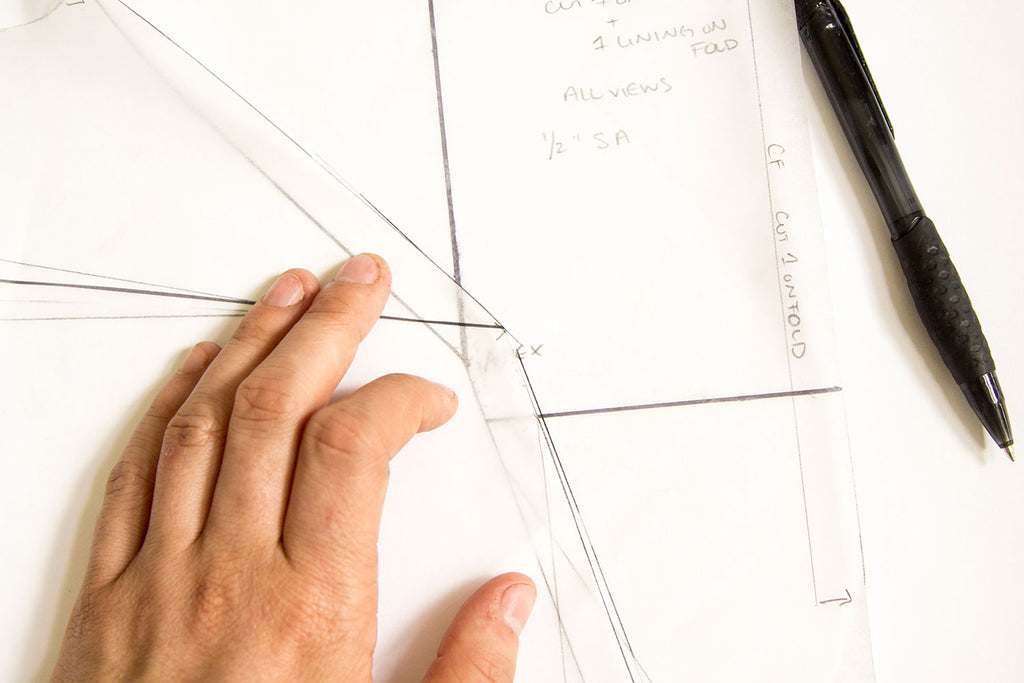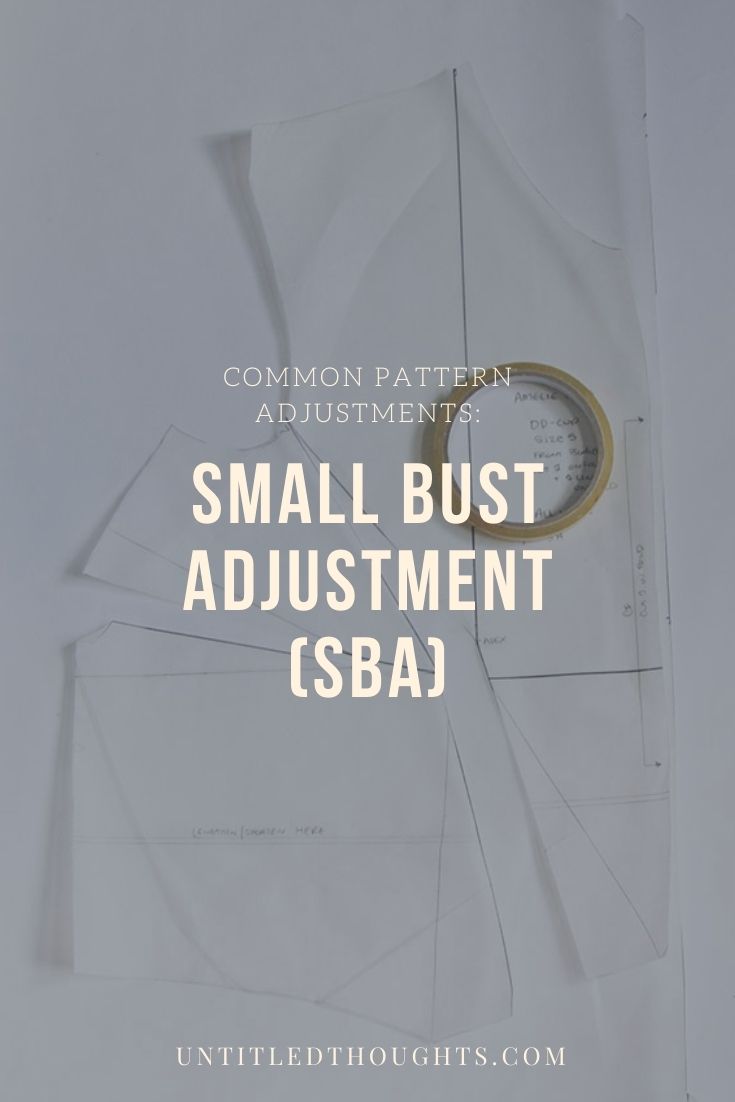Last week, we took a look at performing an FBA (Full Bust Adjustment) to your pattern pieces using the Amelie Bodice as our example. This week, we will be looking at the opposite side of things in the form of an SBA (Small Bust Adjustment).
We learned that with an FBA, generally your clothing (prior to the alteration) may have fit perfectly in every single area except for right at the bust. In the bust area, you may have experienced lots of pulling from the fabric, buttons not wanting to stay closed, or the squishing of your chest. When determining whether or not you need an SBA, the opposite issues are what we are generally looking for.
If you aren't sure whether an SBA is the right alteration for you, ask yourself a few of the following questions.
- Do you tend to have extra room in the bust area and feel as if it isn't being filled out properly?
- Does your bust measurement generally fall into a smaller size group that your waist measurement?
- Do you ever notice the waist line of your garments sagging below your natural waist?
If you answered yes to any of the above questions, chances are you'll want to try performing an SBA.
Before we jump in to cutting up and testing out our first SBA, we need to do a bit of math to determine just how much fullness we need to take away from our garment. The simplest way to determine how much to reduce our garment fullness by in the bust is to simply find the difference between the pattern's finished bust measurement and your own full bust measurement.
Take a look at the pattern's measurements. When you have a smaller bust, you actually will want to use your waist measurement to determine which sized garment to make. (If you need additional guidance on determining what those two measurements might be, take a look at my Quick Guide to Measuring Yourself post). For example, let's say my waist measurement is 26" / 66 cm and my full bust is 34 1/2" / 87.6 cm. That means I should make a size 3 with an SBA according to the size chart below.
Getting back to the math of it....
Since I am using a size 3 B-Cup as my base, there is a 2" (5 cm) difference between my measurements and that of the stated garment measurements (Garment Bust Measurements: 36 1/2" / 92.7 cm ; My Full Bust Measurements: 34 1/2" / 87.6 cm). Don't forget, we are only working with half of a bodice piece, so we actually will only need to take away 1" (2.5 cm) of fullness from our pattern.
Extra Room Being Taken divided by Two Bodice Halves = Width of SBA
I know that was a lot of work, but now you have your measurements for any and all future projects! We can officially get started with our SBA, whew!
SUPPLIES NEEDED:
- Your Traced off Pattern
- Tracing Paper
- Pen or Pencil
- Sharpie
- Paper Scissors
- Tape
- Clear Ruler
*Note: Don't forget to trace off all of the important markings from your pattern, especially the bust apex and the lengthen/shorten lines.
Let's Get Started!
Our ultimate goal with performing this SBA is to take away fullness at the bust point without sacrificing the proper fit at our shoulders and waist points. In order to do this, we will need to start by drawing a few lines on our pattern pieces!
The lines you want to draw are as follows:
- From your Apex Point straight up to your shoulder seam
- Directly through the center of your side dart to your Apex
- Directly through the center of your waist dart to your Apex
- From your Apex point to your armhole (I drew my point a bit lower than recommended- You want to draw your line roughly 1/3 of the way from the shoulder seam to prevent distortion in the armscye)
- Just above where your waist dart ends, horizontally through the center front

Awesome! Now that all your lines are in place, let's get to cutting and hinging our pattern out! There are a few places we will be cutting. It's important NOT to cut through our entire pattern piece. We want to leave a smidgen of the pattern intact so that we can hinge the pieces around and not accidentally distort the outer pattern edges too much!
The first cut we will make is going to be through our waist dart up to the armscye.


Next we will take our scissors and cut through our side dart, stopping just before the apex.

Yay! we are currently done with cutting... for now. Don't let your scissors wander too far as we will need those again!
As you can see, our pattern pieces are nice and malleable. As you pull/ push on the bottom side seam corner, it naturally opens/closes up.

Now it is time to grab your SBA width (mine was 1" after doing all that math), some tracing paper, some tape, and your ruler.
When working on the hinging part of this process, I like to tape down the part of my pattern piece that shouldn't be moving, just so I don't have pieces flying all over the place! That part is mainly the right side of my pattern. If you don't want to use tape, feel free to use some pattern weights to weigh this part down and keep it from moving for now!
Now is the time to hinge our pattern closed by our new SBA width! Gently push the bottom side seam corner of your pattern in by the SBA width you determined you would need.

 Please note that the pictures above show me performing a 1/2" / 1.3 CM SBA- I accidentally used the incorrect measurement throughout the photographing process. This should have been 1" / 2.5 cm.
Please note that the pictures above show me performing a 1/2" / 1.3 CM SBA- I accidentally used the incorrect measurement throughout the photographing process. This should have been 1" / 2.5 cm.
Both your side dart and armsyce will have changed slightly in this process- that is ok! When we take away fullness in one area, it will affect other areas as well! Go ahead and tape down your new side dart. Leave your waist dart untaped for a moment- we still have one more adjustment to make to our pattern before we can tape it down for good.


Did you notice that when you moved your waist dart that the length of your bodice also shifted and it is no longer even on either side of your dart? Smaller busts tend to need less bodice length because we have less distance to accommodate over the bust before meeting our waistline. This is why if your waist lines tend to sag, you should look at doing your SBA prior to altering the bodice length as it may solve two problems at once!
So now, we just need to make our center front match our new waistline. Cut along line 5 of your pattern piece (Clean off! No hinges this time!) and gently slide it up until your lengthen/shorten lines are even on either side of your soon-to-be-new waist dart.


Now we can tape down our entire pattern piece and cut away the excess tracing paper. Don't celebrate just yet- we aren't quite finished!
We need to redraw our dart legs for our new sew of darts. Remember, we just wanted to take a bit of fullness away at the bust point, but we want to keep our waist measurement the same, so we need to redraw those darts!
First we have to find the bust apex, but we aren't going to simply use the pattern's old apex to find it! Since this garment is meant to fit YOU, let's find your apex! Hold your pattern piece up to your body and mark the fullest point of your bust onto your pattern.
We don't want our bust darts coming right up to the apex- that is what happened when I was testing the Amelie and guess what it produced? Loads of Madonna-esque dart points. So unless that is the look you are striving to achieve (no judgments if you are after that look, I just know many aren't particularly fond of it in RTW), we want our bust dart tips to be AT LEAST 1 inch away from the apex.
As you perform SBAs on your future patterns, you will slowly find out what measurement works for your body as it can vary from as little as 1” to more than 2”+.

Using your new dart tip, let's connect that point to our old dart leg ends. Ignore the actual dart legs and just focus on hitting the ending points of your old dart to form a completely new dart, perfect for you!

Alright, we are ALMOST there! All we have left to do is true up our darts.
To do this, we are going to fold our darts closed in the same way we intend to sew them. Match up the two legs and tape or weight the edges down.


Then cut that excess paper off right at the side seam line! This ensures that we create the proper "triangle" piece typically seen on dart ends that gets sewn into the side seams later on. Repeat this step for your waistline dart. We also want to smooth out the armscye a bit, so simply redraw a smooth line at the point you hinged and then cut around that new point.

Ta-Da! You now have a pattern that will fit your shoulders and waist AND keep the girls all nice and cozy! Go ahead and sew up your new pieces out of Muslin whenever you have the opportunity to see how it all fits. If you like the fit, feel free to trace off this very cut-up SBA bodice onto thicker paper that you can use again and again and again and again!





 Please note that the pictures above show me performing a 1/2" / 1.3 CM SBA- I accidentally used the incorrect measurement throughout the photographing process. This should have been 1" / 2.5 cm.
Please note that the pictures above show me performing a 1/2" / 1.3 CM SBA- I accidentally used the incorrect measurement throughout the photographing process. This should have been 1" / 2.5 cm.